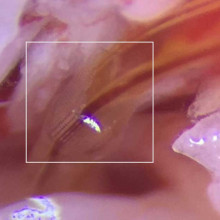Nanoscribe developed and distributed 3D printer and grayscale microfabrication lithography systems, including the Quantum X shape. The laser lithography system is based on the Two Photon Polymerization and combines proprietary printing technologies. Below we present new developments and applications of 3D micro printers.
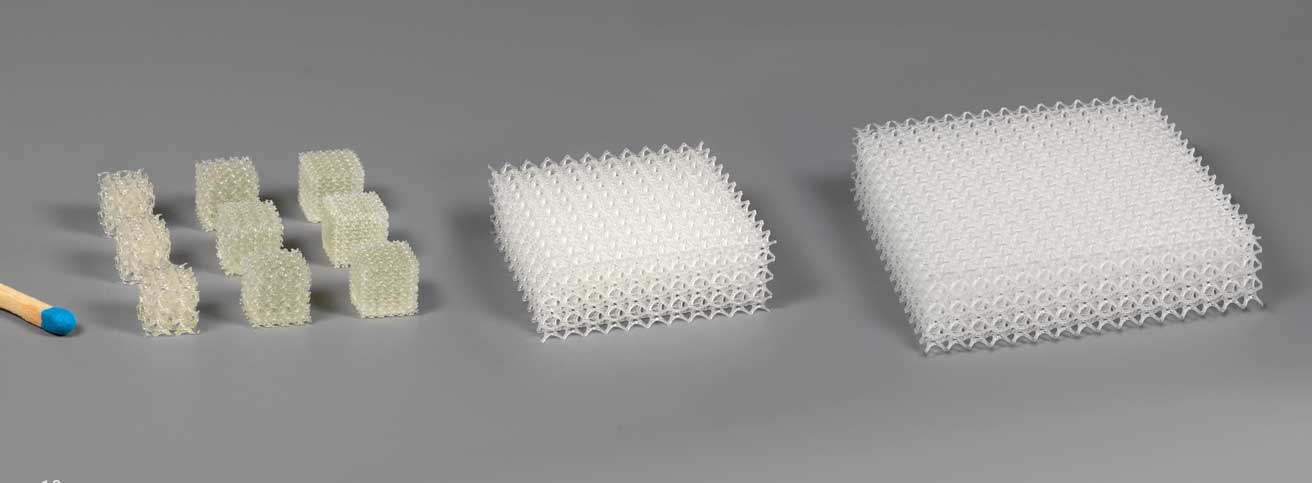
Contents
- 3D microfabrication for printing centimeter-sized structures
- Cochlear implant improved with 3D printing of microstructures
- 3D printing of sensors for extremely high-performance lenses
3D microfabrication for printing centimeter-sized structures
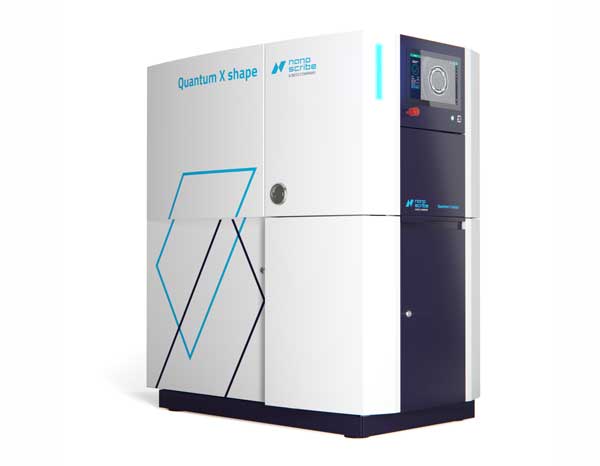 09.03.2022 | Nanoscribe introduces the Extra Large Features (XLF) Print Set, which expands the manufacturing range of the high-precision 3D printer Quantum X shape enhanced. This enables microprinting of nanoscale and microscale structures on millimeter and centimeter-sized objects based on two-photon polymerization. Filigree details and particularly complex structures are retained. In particular, the new XLF Print Set accelerates the high-precision 3D Print by a multiple. This makes the Quantum X shape suitable for the first time as a tool for the series production of voluminous objects that are millimeters or even centimeters in size.
09.03.2022 | Nanoscribe introduces the Extra Large Features (XLF) Print Set, which expands the manufacturing range of the high-precision 3D printer Quantum X shape enhanced. This enables microprinting of nanoscale and microscale structures on millimeter and centimeter-sized objects based on two-photon polymerization. Filigree details and particularly complex structures are retained. In particular, the new XLF Print Set accelerates the high-precision 3D Print by a multiple. This makes the Quantum X shape suitable for the first time as a tool for the series production of voluminous objects that are millimeters or even centimeters in size.
Nanoscribe's high-precision 3D printing technology is based on the Two Photon Polymerization (2PP). This makes it more precise than comparable technologies such as high-resolution SLA and DLP or projection micro stereolithography (PµSL). The print results achieved using two-photon polymerization-based 3D printing are two to five times more precise than those of comparable microfabrication.
So far, 2PP has been limited to object sizes of just a few mm. This is extremely precise using the XLF Print Set 3D printing process now seamlessly centimeter-sized objects applicable. Objects up to 30 cm³ in size can be produced in just one pass.
Highest accuracy at high speed
"With the XLF Print Set, the Quantum X shape opens up completely new possibilities for high-precision 3D printing," says dr Michael Thiel, Chief Science Officer and co-founder of Nanoscribe. "First and foremost, you gain enormous speed when producing large quantities of voluminous objects in one printing process," says Thiel, summing up a central advantage of the new XLF Print Set.
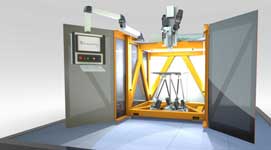 3D printer | Additive manufacturing of plastic parts
3D printer | Additive manufacturing of plastic parts
With the Quantum X shape, Nanoscribe offers a sophisticated Laser basede 3D printer platform with reliable workflows and simple processes. This means that the new XLF Print Set can be used to achieve precise and true-to-form printing results very quickly. The XLF Laser Print Set includes a new aerial lens with a 3200x magnification factor. This leads to a significantly increased pressure field diameter of up to 18,5 µm and a fairly large working distance of XNUMX mm.
The XLF Print Set also offers a high scanning speed, adjustable voxel sizes and a highly sensitive photopolymer based photoresist. It is therefore ideal for prototyping and manufacturing e.g. B. mechanical parts such as millimeter-sized connectors and objects, microfluidic channels and scaffolding structures for biomedical Research.
Cochlear implant improved with 3D printing of microstructures
 27.01.2020/3/XNUMX | Based on Nanoscribe's XNUMXD microfabrication of microstructures, scientists have developed a new cochlear implant developed. Microstructures produced using 3D printing release steroids via the smallest structures. With this, the researchers are bringing together a high-precision 3D printed steroid reservoir and a 2D MEMS-based electrode array for the production of new cochlear implants for the first time. The cochlear implant design was designed to reduce residual hearing damage from lead insertion trauma.
27.01.2020/3/XNUMX | Based on Nanoscribe's XNUMXD microfabrication of microstructures, scientists have developed a new cochlear implant developed. Microstructures produced using 3D printing release steroids via the smallest structures. With this, the researchers are bringing together a high-precision 3D printed steroid reservoir and a 2D MEMS-based electrode array for the production of new cochlear implants for the first time. The cochlear implant design was designed to reduce residual hearing damage from lead insertion trauma.
3D printing of sensors for extremely high-performance lenses
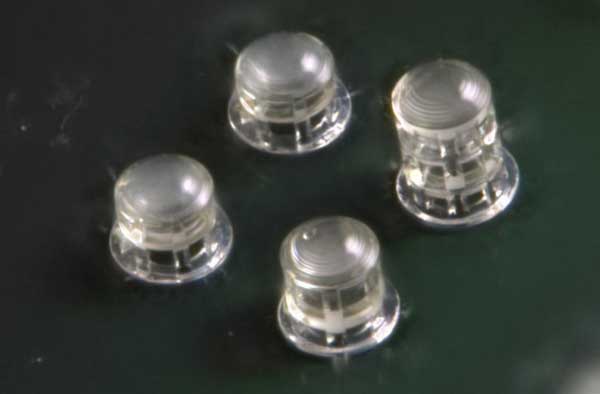 15.02.2017/XNUMX/XNUMX | Eagle eyes are extremely sharp and see well both to the front and to the side - characteristics that one would also like to have in autonomous driving. Physicists at the University of Stuttgart have now 3D Print Sensors manufactured that replicate the eagle eye on a small area and realize it with the latest 3D printing technology from Nanoscribe. Eagles are able to spot a mouse in a meadow from a height of 3 km.
15.02.2017/XNUMX/XNUMX | Eagle eyes are extremely sharp and see well both to the front and to the side - characteristics that one would also like to have in autonomous driving. Physicists at the University of Stuttgart have now 3D Print Sensors manufactured that replicate the eagle eye on a small area and realize it with the latest 3D printing technology from Nanoscribe. Eagles are able to spot a mouse in a meadow from a height of 3 km.
At the same time, eagles have a very wide field of vision, allowing them to perceive enemy birds and other animals approaching from the side. The reason for the proverbial eagle view are extremely many visual cells in the central fovea, a depression in the center of the yellow spot, the area of sharpest vision. In addition, eagles have a second fovea at the edge of their eyes, which ensures sharp vision to the sides.
The driver would like to have something similar for himself self-driving vehicle: Forward should be his Camera see particularly clearly, recognize obstacles and estimate the distance to the vehicle in front, but the field of vision should also be kept in view to the side. Previously, this required a whole range of cameras and sensors around the vehicle or a rotating camera on the roof.
Simon Thiele from the Institute for Technical Optics and his colleagues Harold Giessen from the 4th Physics Institute at the University of Stuttgart have now developed a sensor that reproduces this eagle eye on a small area. The research was located under the umbrella of the Scope research center at the University of Stuttgart and was realized thanks to the latest 3D printing technology from the Karlsruhe company Nanoscribe.
Micro objective lenses from telephoto to wide angle
The Stuttgart researchers printed directly onto a high-resolution CMOS chip a whole set of micro objective lenses that have different focal lengths and fields of view. The smallest lens has a focal length equivalent to a wide-angle lens, followed by two lenses with a more medium field of view, and the largest lens has a very long focal length and small field of view, like a typical telephoto lens.
The 3D printer creates the Lentils directly onto the CMOS chip using what is known as two-photon polymerisation. In this process, two photons from a red femtosecond laser pulse are absorbed in the photoresist and act like a blue photon, which initiates the crosslinking process in the liquid photoresist. A scanner is used to write layer by layer of the free-form lens structure.
 3D printing service – online and fast
3D printing service – online and fast
All four images generated by the lenses on the chip are electronically read out and processed at the same time. A small computer program puts the image together in such a way that the high-resolution image from the telephoto lens is displayed in the center and the image from the wide-angle lens is displayed on the very outside. The researchers tested their new camera on various test objects and were able to improve the resolution in the center of this so-called foveated imaging clearly demonstrate the system.
Suitable for Industry 4.0 applications
Since the entire sensor system is only a few mm² in size - the lenses have diameters in the range from 100 to a few 100 µm - in addition to the Automotive industry also novel mini drones benefit from the technology. The sensors are already connected to a small minicomputer that has its own IP address and can be addressed and read directly via the smartphone. The system is therefore already suitable for Industry 4.0 applications.
 3D Printer Material | from plastic to metal
3D Printer Material | from plastic to metal
You might also be interested in...
